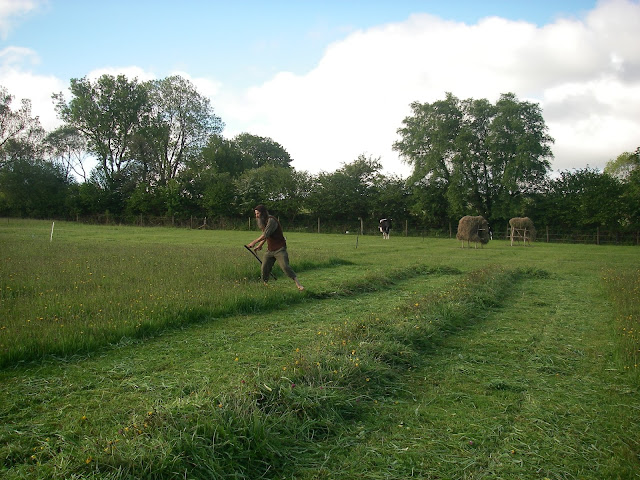Here at Dyfed Permaculture Farm Trust,
as in any garden or small holding, some areas need to have higher
fertility then others e.g. to enable growing of hungrier crops. One
way we achieve this is to move fertility from areas were it is not
needed (paths, tracks) or even actively not wanted (wild flower hay
meadows) to those were it is more useful (annual veg beds, forest
gardens).
The scythe allows us to collect mulch
material from many areas and use it to improve soil and fertility in
the gardens. There are many types of mulch that we collect, each
useful in different ways. Lawn clippings and clippings from
frequently cut paths are fine and generally weed free as the grasses
do not get to seed before cutting. They make a good mulch around
small, newly established plants such as these parsnips.
 |
| Parsnip with grass mulch |
Longer grass and weeds are mown from
less frequently used paths, tracks and garden edges. They are more
useful around more established plants, such as brassica and squash
family.
Sometimes the mowings don't even have
to be moved – by mowing anticlockwise around a fruit tree the
mowings will naturally fall in a ready made mulch “doughnut”.
Comfrey can be grown around fruit bushes and fruit trees, then mown
down and left in place. Paths can be mown into the edges of beds to
mulch and create a neat finish.

Sometimes mulch collection can double
as weed control. We scythe areas of bracken in late summer / early
autumn, removing the cut material to winter mulch garden beds. If
left on the field, bracken is self mulching. Removing the material
allows competitive grasses to establish and exposes the bracken to
penetrating frost which can weaken the plants.

The scythe is also involved in hay
making on the Trust's wild flower hay meadows. To maintain the
fields in a low fertility state that benefits the wild flowers over
the grasses, the fields need to be cut annually in mid summer and
the arisings removed. Some of this is made into hay for winter animal
feed. Hay also makes excellent mulch material for no-dig potatoes. We
have successfully used mowings from the hay fields in thick (several
feet) layers to establish and maintain developing forest garden
areas, either fresh or as hay, something worth noting if you are
establishing or managing an area of wild flower meadow but have no
need to make hay.

Now we have more livestock more of our
hay will be processed through them before the fertility arrives where
it is wanted. The ducks forage around the farm, the goats eat grass,
browse and hay then both are housed overnight on comfy beds of old
hay. In the winter, fertility from the cow will be similarly
collected. Once composted, soiled bedding is a valuable addition to
the system.
For more information on how we manage a permaculture small holding by hand, see www.scythecymru.co.uk





